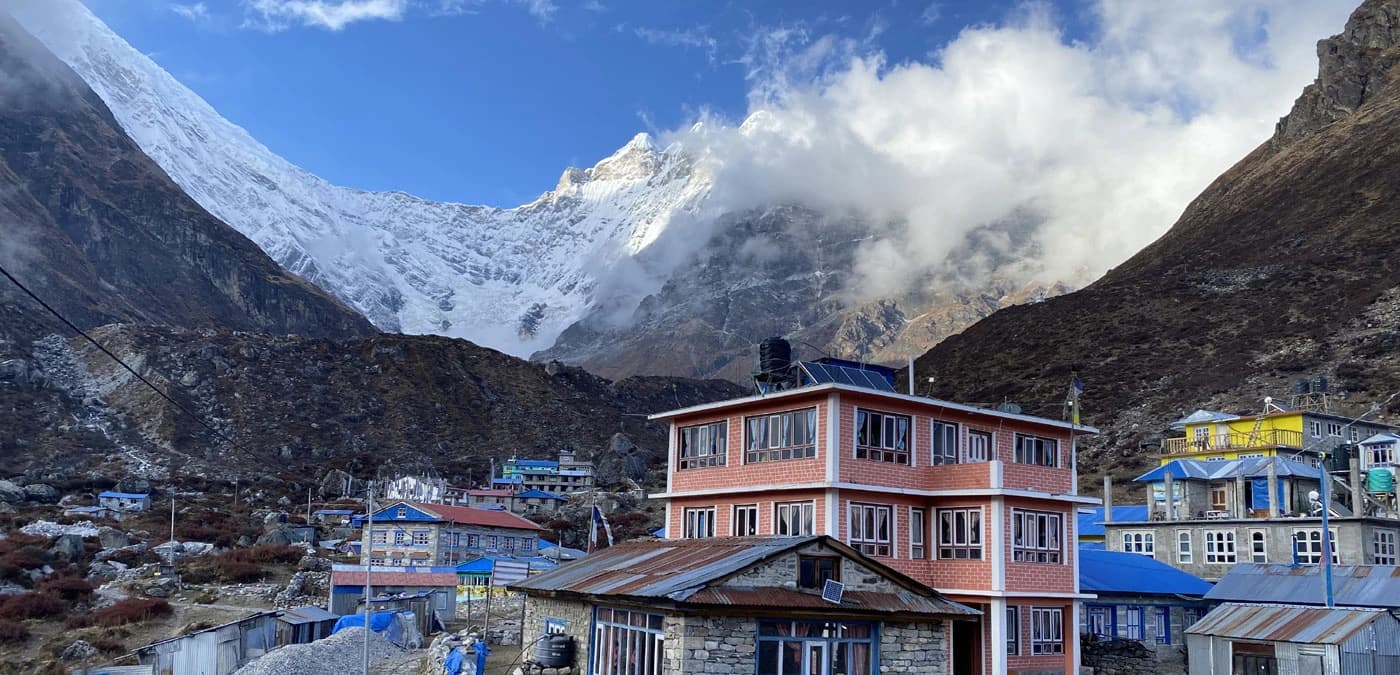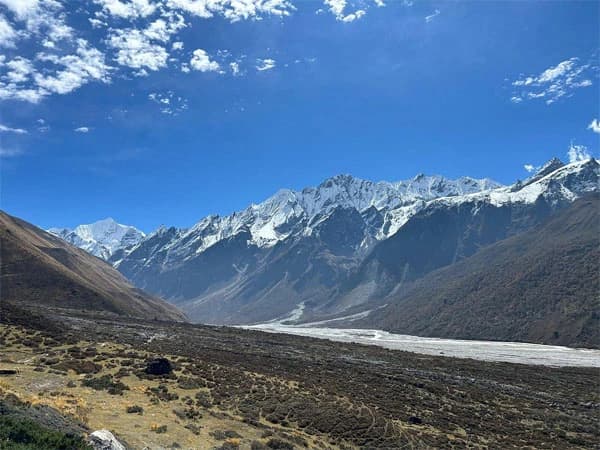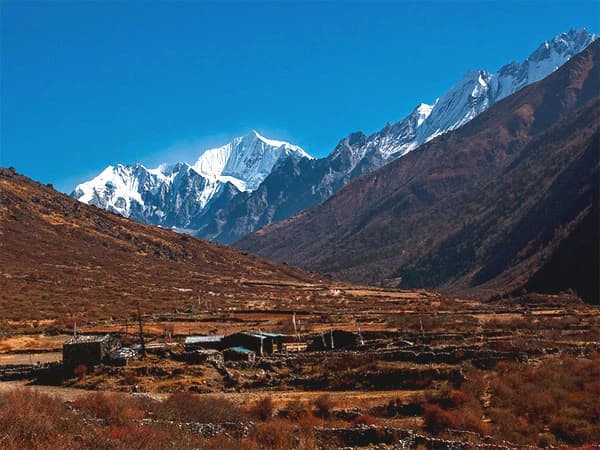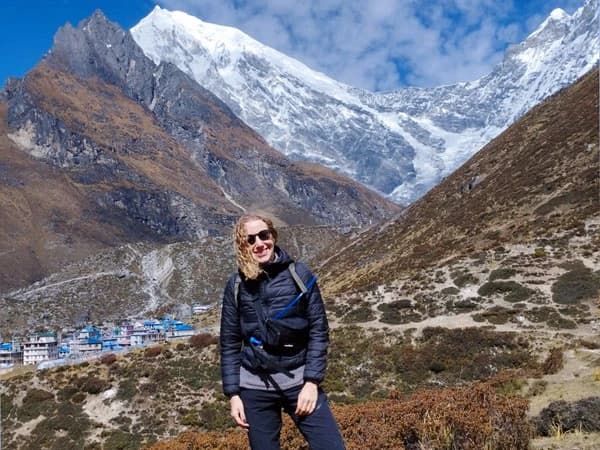Langtang Village is a hidden treasure away in the heart of white-crowned mountains shadow. It is a spot on a trekker's map, and an aliveness of painting culture, strength, and the unobtrusive magnificence of nature. Hidden away deep in the upper reaches of the Langtang Valley, the village provides adventurers with an actual window into Tamang culture, Himalayan fauna, and the cadences of mountain existence. Join me on this cyber trip as I take you into every nook and cranny of Langtang Village its people, history, trails, and the very things that make it one of the best choice ever.
Langtang Village
Approaching Langtang: The Road from Kathmandu
Your odyssey will most likely begin in Kathmandu, the capital of Nepal. A six-to eight-hour meandering journey towards north takes you to the Gateway to Langtang vallry trek: Syabrubesi. The road winds its way up from rice-terracing paddy fields, pine, and wooden houses villages, giving a glimpse of the Nepalese countryside heartland. You won't be surprised if your stomach is tested by bendy highway; it is the Himalayan experience.
By late afternoon, you will arrive in a Syabrubesi, a small market town perched beside the roaring Bhote Koshi River. Here, teahouses spill laughter and hot butter tea stream into the cold mountain. It is the final outpost of modern amenities Wi-Fi hotspots internet cafes and bakeries before the trail head beckons.
Day 1 is an easy day's walk as you will set foot off from Syabrubesi on a wide hiker’s track along the top ridges of hills above the river. Bamboo is succeeded by rhododendron, and around each bend of path another panorama of Langtang Lirung's granite peaks. Overnighting in tiny villages of Bamboo and Ghodatabela provide rudimentary lodges, dal bhat mid-day meals, and the first encounter with thin high-altitude air.
By second, you’ll rest at Lama Hotel, named after the tiny Gompa that overlooks it. Here, yak bells trill as dusk drapes the valley in violet shadows. You’ll feel your heartbeat sync with the wind whispering through tall pines.
Day 3 takes you to Langtang Village proper, a five- or six-hour trek. The trail gets narrower, wedged between steep ridges and the Langtang River thundering below. Walk across rickety wooden suspension bridges suspended over, their wooden boards creaking underfoot. Blue poppies, primulas, and orchids cover the spring forest floor.
You arrive after lunch to find stone-walled houses huddled on a stepped slope. Prayer flags surround doorways and wave above, bearing silent blessings downstream. A mixture of wood and slate, they appear to have sprouted out of the hillside itself.
The Tamang Heartbeat: Culture and Community
Language & Religion
Tamang villagers, Tibetans by origin, are the core of Langtang Village. Their Tamang‐Smu dialect echoes off the mountainsides as villager’s labor on barley scarves, herd cattle, and tend vegetable plots. Tibetan Buddhism is blended with animistic spirits stone cairns dot ridges, and mani walls (inscribed with lucky mantras) guide your path.
Homes & Hospitality
Stepping into a Tamang home, you’ll perch on low wooden stools around a central hearth. Butter lamps flicker beside statues of Avalokiteshvara. A hostess might ladle sweet, salty yak butter tea into tin cups, offering a warm, milky comfort that chases chills from your bones. Dinner is often dal bhat lentils, rice, seasonal greens, and spicy achar (pickle) shared family-style.
The 2015 Earthquake
A 7.8 quake struck mid-Nepal on April 25, 2015. Early April 26, massive avalanches swept Langtang Valley, burying Langtang Village in snow and debris. At least 300 died; a number of buildings were destroyed to the ground level. But from tragedy, there emerged heroes' tales. Monks at the village monastery survived their experience by huddling inside the impenetrable stone walls, convincing neighbors to escape to safety and rationing scarce supplies.
Villagers, NGOs, and the government collaborated after the earthquake to rebuild the Langtang village again. Solar panels crown roofs where once there were kerosene lamps. Unshakeable stone homes, thatched with wooden beams interwoven, cannot so readily be destroyed by an earthquake were all rebuilt. A new primary school resounds with children's laughter; a basic health post offers rudimentary care. Guesthouses reopen in village hands to permit trekking revenues and to return into village coffers.
Beyond Langtang Village: Side Treks and Summits
Kyanjin Gompa
The culmination of a breathtaking ascent and frosted white ridges has surround this mountain village. It is renowned for yak cheese, and you can visit the village cheese factory where hand-made curds and sour yogurt from yak milk are still produced today. It is a unique chance to sample locally-made foodstuffs and see traditional method. Locals nearby stand silent alone before the ancient 18th-century monastery, whose walls are lined with worn-out murals. In the wake of wind blowing through the valley, prayer wheels are slowly turning, and a spiritual rhythm is sent into clean mountain air.

Tserko Ri Viewpoint
There is a steep and rocky trail, just beyond the village, leading to Tserko Ri (4,984 m), one of Langtang's highest and most rewarding viewpoints. Pre-dawn ascent in dawn breaks, the mountaineers ascend to the top with the first sunbeams hugging the white peaks in golden and red warm hue. The panoramic view comprises Langtang Lirung, Yala Peak, and even Kumbhakarna on a clear morning. Atmospheric condition at such altitude is scarce and chilly, thus layering up and ascending step by step acclimatizing is reasonable.
Sustenance for the Soul: Local Cuisine
- Dal Bhat: The Nepalese staple lentil soup, steamed rice, curried vegetables, and a side of achar.
- Momo: Steamed or fried dumplings filled with yak or buffalo meat, served with spicy tomato chutney.
- Thukpa: Noodle soup with vegetables and optional meat, perfect after a chilly morning trek.
- Yak Butter Tea: A rich blend of tea leaves, yak butter, salt, and warm water a calorie-dense hug in a cup.
- Swari (Tibetan Bread): Flatbreads baked on hot stones, crisp outside, chewy within.
Each meal is a reminder that simple ingredients like rice, lentils, barley, tubers nourish bodies and bind communities.
Preparing for Your Journey
- Permits: Obtain the Langtang National Park entry permit and a TIMS card (Trekkers’ Information Management System).
- Gear: Insulated jacket, waterproof boots, warm hat, sunglasses, headlamp, and a trekking pole.
- Health: Acclimatize slowly; drink plenty of water. Consider a portable oxygen canister for emergencies.
- Insurance: Ensure coverage for high-altitude trekking and helicopter evacuation if needed.
- Packing: Layered clothing, sunscreen, first-aid kit, water purification, snacks, and a camera.
A well-prepared trekker stays safe, comfortable, and fully present to absorb the Langtang valley’s magic. You must keep your pace slow yet steady while trekking in the Langtang region as being in hurry is lost in whispering pine and winding rivers. Mornings start with monastery prayers and end under a starry canopy that city lights have never known. Loiter awhile over butter tea, chat with seniors carving mani stones, or just park your rear on a rock and have the wind sweep your thoughts away. That is where the true gift of the village is revealed a deep stillness, a balance of people and peaks.
Why Langtang Matters?
Langtang Village is at the crossroads of the past and the present, of tradition and tourism, of destruction and revival. It shows us how to live above skies, how conservation and culture can walk hand in hand, and how we, as humans with rational choices, can leave a good foot print even at 3,500 meters above sea level.
If you're a salted hand for trekking or an early explorer, Langtang dares you to trade boardwalks and guidebooks. It dares you to listen to the rustle of prayer flags, the school kids' giggles in the school plaza, and your own boots cracking on older trails. And it rewards you with connection: with earth, with people, and with something greater than ourselves.
So when your boots finally touch the soil of Langtang Village, pause; Look around and feel the pulse of a place both fragile and fiercely alive. And carry its story forward, long after you have descended back into the lowlands. May your journey to Langtang be safe, transformative, and unforgettable. Let’s take a look on what makes the Langtang village special:

Elevation and Setting
Langtang Village (3,430 m / 11,250 ft) is situated half-way up the valley and under the shadow of a cluster of giant peaks like Langtang Lirung (7,227 m). Rock face and grass alpine pasture terrace form the valley floor which is smothered with over-slopes of oak, maple, and rhododendron, blooming into scarlet and pink every April–May.
Glacial Features
Further up, Langtang Glacier chiseled out an ice-moraine Rockland. Brief side hike provides an unforgettable glacial lake, with shattered blue ice afloat on tranquil water. Gentle morning sun on the ice fields creates a soft radiance which, having now experienced it, stays with you.
Flora and Fauna
Seek out Himalayan marmots scrambling between rocks, langur monkeys leaping through the forest, and, if luck holds, the rare red panda. Wildflowers like primula and gentian blanket the terrain in spring; autumn sees golden grasses undulating under crystal-clear skies.
Cultural etiquette and things to consider in Langtang Village
Langtang Village nestled into the heart of Himalayas is rich in tamang traditions and Tibetan Buddhist culture. Festivals celebrated by these ancient communities are Lhosar, Mani Rimdu Festival, Janai Purnima and, Tarna festival. These festivals are the important parts of the culture of the people living in the Langtang region. It has its own unique charm, beauty and cultural experiences.
Trekking in the Langtang region is one of the rare chance to explore the untouched beauty of the Himalayas of Nepal. It offers an opportunity to explore the typical Tibetan Buddhist culture in the lap of nature. As there are many Gompas and mani walls on your way you must be careful and do not step or point at those spiritual beliefs.
Visit during Sonam Lhosar (Tamang New Year, late January/early February) to see the valley erupt in color. Locals wear beaded jackets and silver ornaments, beat damphu drums, and perform the Tamang Selo dance. Homes are filled with sel roti (sweet rice doughnuts) and millet beer brewed using fermented millet. Even reticent tourists are caught up in circle dancing under starry nights.
Tamang villagers originally had arrived from Tibet centuries ago. Wooden houses of theirs nailed together are charmingly primitive in appearance and sharply pitched roofs to enable snow to slide off. Langtang was an old trade town a century ago on roads linking Tibet and Kathmandu. Langtang Gompa, perched above the townspeople, provided shelter to students of earlier generations who transcribed Buddhist texts late at night using candles.
Prayer wheels’ spin behind inscribed stones which rotate "Om Mani Padme Hum." Mani walls line trails, and chortens (stupas) enclose sacred sites. Mask dances and communal festivals break out in the valley during Losar (Tibetan New Year). Strangers are welcomed. Formal welcome: butter tea and Tsampa (roasted barley flour made into a tea). Culture and etiquette of this region is truly remarkable.
Conclusion
Langtang Village stands as a living testament to the strength of community and the beauty of simplicity. After the hardships of past years, its people rebuilt with grace, weaving new hope into every stone wall and prayer wheel. In the gentle chatter of daily life of children playing to river, elders sharing stories by the heart you will sense a spirit that refuses to be hurried or forgotten.
As you leave the village behind, carrying memories of misty mornings and star-filled nights, remember that Langtang’s real gift is perspective. Here, time slows, priorities shift, and you’re reminded that kindness, resilience, and a deep respect for nature are treasures far richer than any summit view. Langtang Village invites you to carry this lesson home: that in even the smallest places, we can find the greatest inspiration.





